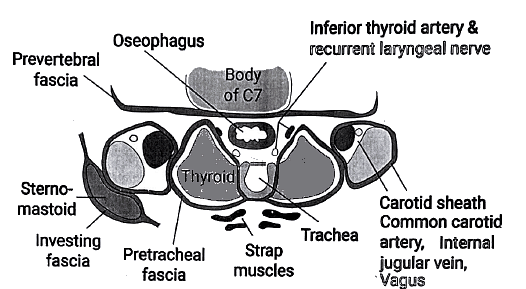Thyroid Gland: Miscellaneous | Medical Science Optional Notes for UPSC PDF Download
Thyroid gland-Gross Anatomy
The thyroid gland is comprised of two lobes, namely the right and left lobes. Each lobe has dimensions of approximately 5cm x 2.5cm x 2.5cm, extending from the middle of the thyroid cartilage to the Fourth/Fifth tracheal ring. These lobes are interconnected by an isthmus measuring 1.2cm x 1.2071cm in the lower parts. Notably, the size of the lobes tends to be larger in females during pregnancy and menstruation.

The gland is enveloped by a pseudo or false capsule created by the Pretracheal layer of the deep cervical fascia, while the authentic capsule is shaped by the peripheral condensation of the gland's connective tissue. To prevent hemorrhage during surgical procedures, the thyroid is excised along with the genuine capsule.

The False capsule, known as the Suspensory Ligament of Berry, is constituted by the Pretracheal layer of the deep cervical fascia. While it is thin along the posterior border of the lobes, it becomes thicker on the inner surface of the gland, creating the Suspensory Ligament of Berry. This ligament connects the thyroid lobe to the cricoid cartilage.
Relations of lobes of the thyroid

Relations of Isthmus of the thyroid


Thyroid gland-Blood supply
Arterial supply
The thyroid gland receives arterial supply from the superior and inferior thyroid arteries.
Superior Thyroid Artery:
- A branch of the external carotid artery.
- It descends in front of the external laryngeal nerve.
- The artery pierces the Pretracheal fascia to reach the upper pole of the trachea.
- It subsequently divides into anterior and posterior branches.
- The anterior branch courses along the anterior border of the thyroid, following the isthmus.
- The posterior branch travels along the posterior border, forming an anastomosis with a branch of the inferior thyroid artery.

Inferior thyroid artery
- It stems from the thyrocervical trunk.
- Following its origin, it ascends and moves medially before descending to reach the lower pole of the gland.
- In its terminal segment, it has proximity to the recurrent laryngeal nerve.

Note: The superior thyroid artery provides blood to the upper one-third of the thyroid lobes and the upper half of the isthmus, while the inferior thyroid artery supplies the remaining portion of the gland.
In approximately 3% of the population, there is an extra artery known as the thyroidea ima artery, originating from either the brachiocephalic trunk or the arch of the aorta.
Venous supply
- The superior thyroid vein originates in the upper pole of the gland and empties into the internal jugular vein.
- The middle thyroid vein originates near the middle of the gland and drains into the internal jugular vein.
- The inferior thyroid vein, originating near the lower border of the isthmus, drains into the left brachiocephalic vein.
- The fourth thyroid vein of Kochee, situated between the middle and inferior veins, drains into the internal jugular vein.
Thyroid gland-Lymphatic drainage
Lymphatic vessels of the thyroid connect with the tracheal plexus and extend to the prelaryngeal nodes located just above the thyroid isthmus, as well as to the pretracheal and paratracheal nodes. Some may also direct drainage into the brachiocephalic nodes associated with the thymus in the superior mediastinum. On the lateral aspect, vessels along the superior thyroid veins drain the gland into the deep cervical nodes. Additionally, thyroid lymphatics may establish a direct drainage path to the thoracic duct without an intervening node.
Thyroid gland - Repeats
- Discuss the development of thyroid gland and its blood supply (2002).
- Describe the thyroid gland under the following headings (2013)
i. Lobes
ii. Relations
iii. Surgical anatomy
|
7 videos|219 docs
|
FAQs on Thyroid Gland: Miscellaneous - Medical Science Optional Notes for UPSC
| 1. What is the gross anatomy of the thyroid gland? |  |
| 2. What is the blood supply of the thyroid gland? |  |
| 3. How does the thyroid gland drain lymphatically? |  |
| 4. What are some miscellaneous facts about the thyroid gland? |  |
| 5. How can thyroid gland disorders be treated? |  |

|
Explore Courses for UPSC exam
|

|
















